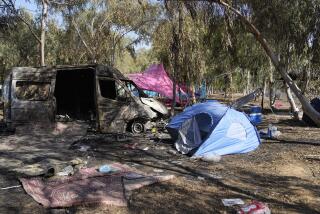Educating Teen-Agers on Rape: What Is It?
H ere’s the scenario: A 16-year-old girl has been dating a 17-year-old boy for a couple of months. One night, he takes her to a party. She doesn’t know anyone, and alcohol is flowing freely. She has a few drinks. At one point, she is having a wonderful time. But pretty soon, as she stands in a corner kissing her date, she decides she isn’t feeling so well. He offers to guide her to a bedroom where she can lie down. She passes in and out of consciousness. At one point, when she comes to, he is on top of her, having sex.
The question: Is this rape?
A sampling of responses from male and female high school students:
* “He was drunk, too, so it wasn’t rape.”
* “Definitely rape.”
* “Maybe she didn’t want to, but she didn’t say ‘no,’ either.”
* “If she hadn’t gotten drunk, she wouldn’t have gotten raped. She should have said no to alcohol.”
* “It wasn’t rape, but he took advantage of her.”
The answer: It is rape. The girl did not agree to have sex. It is against the law to have sex with someone without his or her consent.
The question of what constitutes acquaintance rape provoked strong emotions last week at University High School. Students in two health classes were completing the last portion of a three-day program put on by Santa Monica Hospital’s Rape Treatment Center. The center aims to raise student awareness about acquaintance rape (the expression date rape isn’t used since many teen-agers think of dating as something their parents did).
The 10-year-old program reaches about 6,000 students a year. At one time, six instructors fanned out through the city; state funding cuts have reduced the number to two.
“We are deluged with requests from public and private schools that we just can’t respond to,” says Marybeth Roden, assistant director of the Rape Treatment Center.
There is no way of knowing exactly how effective the program is, but, says Roden: “The feedback is always positive. Students often tell us this is the most valuable class they’ve had in high school. They like the fact that we talk to them like adults.”
Indeed, there is a savviness among the teen-agers. More than one student pointed out that even if the girl had been raped, the boy might never be convicted.
Says Roden: “I like to think we’re educating the jury pool of tomorrow.”
Back in the classroom, instructor Alaina Shapiro is posing questions about the four main contributing factors to acquaintance rape: alcohol, sex-role stereotyping, poor communication and peer pressure.
As she elicits responses, the atmosphere is blame-free. There’s no such thing as a bad answer. The discussion is honest, and lays bare some of the misconceptions teens have about sexual behavior and what constitutes consent.
For example: Shapiro stands at the front of the class. She is pretending to be 16. An imaginary boy has just asked her to have sex.
She looks at the floor, twirls her hair and rocks back and forth, giggling. “No,” she says softly, almost as if it’s a question, “I don’t want to have sex with you.”
In her own voice, Shapiro asks: “Does this girl want sex?”
* “Yeah, but she’s playing hard to get.”
* “Or maybe she doesn’t, but she doesn’t want to offend him. He might get mad.”
Shapiro has demonstrated a classic mixed message. Her words say “no”; her demeanor implies “maybe.” It’s easy to see how this response might be misinterpreted.
“The reality is that people pay more attention to body language and tone of voice than to the words being spoken,” says Shapiro. “Girls need to learn to communicate clearly and firmly.”
She tries it again. This time, she is looking the imaginary boy in the eye. She stands steady on her feet. Her hands are at her side. “No!” she says emphatically, “I don’t want to have sex with you!”
Another class, a final scenario : Two boys at a party watch their friend lead his obviously intoxicated date to a bedroom. It is clear that the friend intends to have sex with the girl.
Question: Should the guys stop him?
* “No. I’d say, ‘Go for it!’ ”
* “Not if I don’t hear any kicking or screaming.”
* “You wouldn’t want your friends to stop you. “
“OK,” says instructor Jill Leevan, “what if the girl is your sister?”
* “I’d beat him up!”
* “He’d be dead right now!”
* “I wouldn’t even let my sister be at a party like that.”
Leevan lets the paternalism slide.
“Don’t you think that girl has a family that cares about her?” she asks. “And don’t you care about your friend? You could be saving him from a rape charge.”
Heads nod.
A boy pipes up from the back: “Anyway, the girl could have AIDS!”
Leevan smiles. It wasn’t exactly the answer she was looking for.
But it will do.
Because of a production error, two paragraphs in Robin Abcarian’s April 11 column were transposed in some editions.
More to Read
Sign up for Essential California
The most important California stories and recommendations in your inbox every morning.
You may occasionally receive promotional content from the Los Angeles Times.











